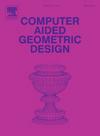Build orientation optimization considering thermal distortion in additive manufacturing
IF 1.7
4区 计算机科学
Q3 COMPUTER SCIENCE, SOFTWARE ENGINEERING
引用次数: 0
Abstract
Additive manufacturing (AM) technology enables the fabrication of three-dimensional objects with complex shapes and has been extensively applied in various industries. AM is a layer-wise fabrication process where a variety of factors affect manufacturing performance and product quality. One of the most important factor is the thermal distortion, which is caused by the high temperature gradients in the fabrication process. The thermal distortion is also influenced by the support structure of the printing object, and this distortion varies depending on the chosen build orientation. Additionally, for the overhang regions, extra supports are required for printing and will be removed in the post-processing. For the 3D printing process, the thermal distortion and support requirements are interconnected and linked to build orientation. To investigate suitable build orientation, the thermal distortion and support are quantified, and a multi-objective build orientation optimization method is proposed to obtain representative orientations. Based on the proposed method, 9 typical 3D shapes are evaluated. In addition, the single-objective build orientation optimization problem is studied and compared, and the influence of slicing layers per stage on the simulation accuracy and efficiency is discussed. The effectiveness and applicability of the method are verified, and representative directions can be obtained for different fabrication purposes.
在考虑热变形的情况下优化增材制造的构建方向
快速成型制造(AM)技术可制造形状复杂的三维物体,已广泛应用于各行各业。AM 是一种分层制造工艺,影响制造性能和产品质量的因素很多。其中最重要的一个因素是热变形,它是由制造过程中的高温梯度引起的。热变形还受到打印对象支撑结构的影响,这种变形因所选的构建方向而异。此外,对于悬空区域,打印时需要额外的支撑,并将在后处理中去除。在三维打印过程中,热变形和支撑要求是相互关联的,并与构建方向有关。为了研究合适的构建方向,对热变形和支撑进行了量化,并提出了一种多目标构建方向优化方法,以获得具有代表性的方向。根据提出的方法,对 9 种典型的三维形状进行了评估。此外,还对单目标构建方向优化问题进行了研究和比较,并讨论了每阶段切片层数对模拟精度和效率的影响。该方法的有效性和适用性得到了验证,并可为不同的制造目的获得有代表性的方向。
本文章由计算机程序翻译,如有差异,请以英文原文为准。
求助全文
约1分钟内获得全文
求助全文
来源期刊

Computer Aided Geometric Design
工程技术-计算机:软件工程
CiteScore
3.50
自引率
13.30%
发文量
57
审稿时长
60 days
期刊介绍:
The journal Computer Aided Geometric Design is for researchers, scholars, and software developers dealing with mathematical and computational methods for the description of geometric objects as they arise in areas ranging from CAD/CAM to robotics and scientific visualization. The journal publishes original research papers, survey papers and with quick editorial decisions short communications of at most 3 pages. The primary objects of interest are curves, surfaces, and volumes such as splines (NURBS), meshes, subdivision surfaces as well as algorithms to generate, analyze, and manipulate them. This journal will report on new developments in CAGD and its applications, including but not restricted to the following:
-Mathematical and Geometric Foundations-
Curve, Surface, and Volume generation-
CAGD applications in Numerical Analysis, Computational Geometry, Computer Graphics, or Computer Vision-
Industrial, medical, and scientific applications.
The aim is to collect and disseminate information on computer aided design in one journal. To provide the user community with methods and algorithms for representing curves and surfaces. To illustrate computer aided geometric design by means of interesting applications. To combine curve and surface methods with computer graphics. To explain scientific phenomena by means of computer graphics. To concentrate on the interaction between theory and application. To expose unsolved problems of the practice. To develop new methods in computer aided geometry.
 求助内容:
求助内容: 应助结果提醒方式:
应助结果提醒方式:


